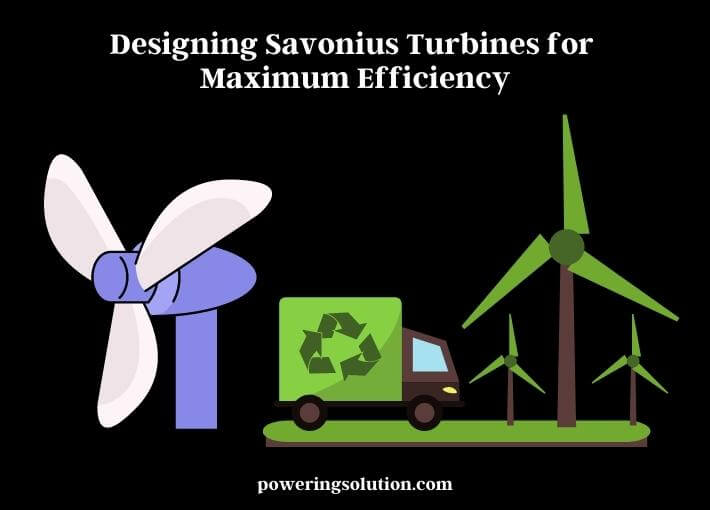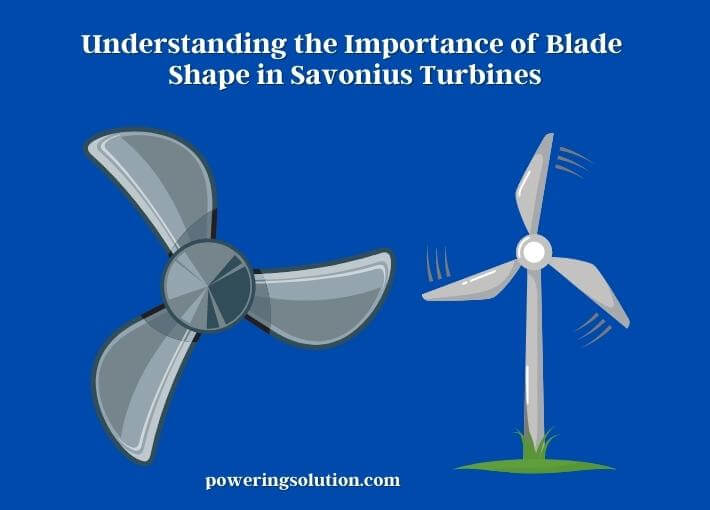Renewable energy sources are becoming increasingly important as we strive to reduce our reliance on fossil fuels. Wind energy is one of the most promising sources of renewable energy, and Savonius turbines are a popular choice for generating wind power in urban areas.

These turbines are compact, affordable, and easy to install, making them a popular option for homes and small businesses. Designing Savonius turbines for maximum efficiency can be challenging, as their curved blades create turbulence that can reduce their performance. In this article, we’ll share some tips on how to design Savonius turbines that can generate maximum energy.
Choosing the Right Materials for Savonius Turbines
Choosing the right materials is essential for designing Savonius turbines that can generate maximum efficiency. The materials used must be strong, durable, and able to withstand the elements. Here are some popular options for Savonius turbine materials:
- Aluminum: Aluminum is lightweight, durable, and an excellent choice for Savonius turbines. It can withstand strong winds and is resistant to corrosion.
- Stainless Steel: Stainless steel is highly resistant to corrosion and is a popular choice for turbines located in coastal areas. It is also strong and durable.
- Carbon Fiber: Carbon fiber is a high-performance material that is strong, lightweight, and able to withstand harsh conditions. It can increase the efficiency of Savonius turbines.
When choosing the material, it is important to consider the overall design of the turbine and the environment in which it will be installed.
Understanding the Importance of Blade Shape in Savonius Turbines
The blade shape is a critical factor in designing Savonius turbines for maximum efficiency. The blades of a Savonius turbine are curved, which can create turbulence and reduce the turbine’s performance. However, optimizing the blade shape can increase the energy generated by the turbine.

There are two primary blade shapes used in Savonius turbines: semicircular and airfoil. Semicircular blades are simpler to construct and can be made from a variety of materials. They have a lower efficiency than airfoil blades, but they are still a popular choice for small-scale turbines.
Airfoil blades are more complex and require a more precise manufacturing process. They are more efficient than semicircular blades, but they are also more expensive to produce. The airfoil shape generates lift, which reduces turbulence and increases the efficiency of the turbine.
When designing Savonius turbines, it’s important to consider the blade shape carefully. The optimal blade shape will depend on the overall design of the turbine and the environment in which it will be installed. By selecting the right blade shape, you can improve the performance and energy output of your Savonius turbine.
If you want to know about vertical-axis wind turbines. Click here for details.
Optimizing the Number of Blades for Maximum Efficiency
Optimizing the number of blades is an important factor in designing Savonius turbines for maximum efficiency. Savonius turbines typically have two or three blades, but some designs use up to four blades. The optimal number of blades depends on several factors, including wind speed and the size of the turbine.
Two-bladed turbines are simpler and less expensive to construct than three or four-bladed turbines. They are also more efficient at low wind speeds. However, as wind speeds increase, two-bladed turbines can become unstable, which can reduce their efficiency.
Three-bladed turbines are more stable than two-bladed turbines and can generate more energy at higher wind speeds. They are also more complex to construct and require more materials. Four-bladed turbines are even more stable than three-bladed turbines and can generate more energy at higher wind speeds, but they are also more complex to construct and require more materials.
When choosing the number of blades for your Savonius turbine, it’s important to consider the wind conditions in the location where the turbine will be installed. If the wind is consistently low, a two-bladed turbine may be the best option. If the wind is variable or high, a three or four-bladed turbine may be more efficient.
Optimizing the number of blades is an important factor in designing Savonius turbines for maximum efficiency. Selecting the right number of blades for the wind conditions in your location can improve the performance and energy output of your turbine.
Calculating the Optimal Height for Savonius Turbines
Calculating the optimal height for Savonius turbines is an important consideration in maximizing their efficiency. The height of the turbine affects the speed and direction of the wind that the turbine can capture. In general, the higher the turbine, the more wind it can capture, but it also increases the cost and complexity of the installation.
To calculate the optimal height for a Savonius turbine, designers can use several techniques. One technique is to use a wind shear exponent, which describes the rate at which wind speed increases with height. By measuring the wind speed at different heights, designers can calculate the wind shear exponent and use it to determine the optimal height for the turbine.
Another technique is to use an anemometer to measure the wind speed at different heights. By analyzing the data collected by the anemometer, designers can determine the optimal height for the turbine.
The terrain around the turbine can also affect the optimal height. For example, if there are obstacles such as trees or buildings nearby, the optimal height may be lower to avoid turbulence and decrease the risk of damage to the turbine.
The size of the turbine can also affect the optimal height. Larger turbines may require a higher height to capture enough wind to generate energy, while smaller turbines may operate best at a lower height.
Designing Savonius Turbines for Wind Direction
Designing Savonius turbines for wind direction is an important consideration for maximizing efficiency. Savonius turbines are drag-type turbines, which means that they operate best when the wind is perpendicular to the blades. When the wind direction is not perpendicular to the blades, the efficiency of the turbine can decrease significantly.
To optimize the efficiency of a Savonius turbine for wind direction, designers can use several techniques. One technique is to use a helical or twisted blade design. This design allows the turbine to capture wind from multiple directions, increasing its efficiency.
Another technique is to use a two-stage Savonius turbine design. The first stage of the turbine is a smaller Savonius turbine that is optimized for low wind speeds and operates well in any wind direction. The second stage is a larger Savonius turbine that is optimized for higher wind speeds and operates best when the wind is perpendicular to the blades.
The orientation of the Savonius turbine can also be adjusted to optimize efficiency for wind direction. For example, by mounting the turbine on a swivel, it can be adjusted to face the prevailing wind direction.
Designing Savonius turbines for wind direction is an important consideration for maximizing efficiency. By using techniques such as helical blade designs, two-stage turbine designs, and adjustable orientations, designers can optimize the efficiency of Savonius turbines in any wind direction.
FAQs
How Many Blades Should a Savonius Turbine Have for Maximum Efficiency?
The number of blades for a Savonius turbine depends on the design and operating conditions. In general, two or three blades are optimal for low wind speeds, while four or more blades may be more efficient at higher wind speeds.
What Materials Are Typically Used in the Construction of Savonius Turbines?
Savonius turbines can be constructed from a variety of materials, including aluminum, steel, and composites. The choice of materials depends on factors such as cost, durability, and weight.
How Do You Calculate the Optimal Height for a Savonius Turbine?
The optimal height for a Savonius turbine depends on factors such as wind shear, turbine size, and the terrain around the turbine. Techniques such as wind shear exponents and anemometers can be used to calculate the optimal height.
What is the Lifespan of a Savonius Turbine?
The lifespan of a Savonius turbine depends on factors such as the quality of materials used, operating conditions, and maintenance. In general, a well-maintained Savonius turbine can last between 10 to 20 years or more.
Summary
Designing Savonius turbines for maximum efficiency requires careful consideration of several factors, including blade shape, number of blades, wind direction, and optimal height. By optimizing these factors, the efficiency of Savonius turbines can be improved, making them a viable option for renewable energy production in residential, commercial, and community settings.
Ongoing research and development in Savonius turbine technology continue to improve their performance and increase their potential for wider use in the renewable energy industry. As we move towards a more sustainable future, the potential of Savonius turbines to contribute to our energy needs should not be overlooked.
